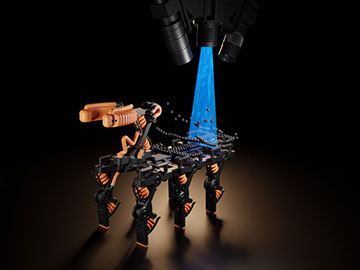
A robot being built layer-by-layer using vision-controlled jetting. The black spheres represent the material that the printer uses. The material is then cured by UV light, represented in blue. At the top of the image are the cameras that scan the procedure and adjust accordingly. [Image: Moritz Hocher]
Robots still can’t decide to build themselves, but—in a twist almost out of science fiction—computer vision can guide the 3D-printing process of complex robotic systems.
Researchers in the United States and Switzerland have developed a contactless 3D inkjet printer that deposits a wide range of materials to create detailed, functional systems (Nature, doi: 10.1038/s41586-023-06684-3). The vision system powers a digital feedback loop that controls the amount of material sprayed by the printer nozzles and eliminates the need for mechanical smoothing of the newly laid-down surfaces.
The process allows fabricators to use materials that cure more slowly than the usual 3D printing polymers—and that have varying amounts of flexibility and elasticity. With the contactless printing system, the research team built a tendon-driven robotic hand, a six-legged walking gripper, a mechanical mammalian heart and a metamaterial surface.
Seeing while spraying
Traditional 3D inkjet printing employs nozzles to squirt fine droplets of low-viscosity resins into their permanent positions, but the product needs to be mechanically “planarized” after the deposition. Softer materials and substances that cure slowly under UV light are not suitable for this fabrication method.
Nearly a decade ago, a group led by Wojciech Matusik, an electrical engineering professor at the Massachusetts Institute of Technology (MIT), USA, developed a low-cost multimaterial 3D printer dubbed MultiFab. The device employed optical coherence tomographic scanning of a small surface to build up layers of resins, but the slow speed of the vision component dragged out the fabrication time.
Vision-controlled jetting

Researchers at MIT produced a functional, tendon-driven robotic hand that has 19 independently actuatable tendons, soft fingers with sensor pads, and rigid, load-bearing bones. [Image: Courtesy of the researchers]
Matusik and his team, including Robert K. Katzschmann and colleagues of ETH Zurich, Switzerland, boosted the speed of the inkjet deposition process by adding a high-speed 3D vision system that incorporates four cameras and two lasers for monitoring the shape of the material being deposited.
First, the system deposits droplets of the raw material onto a support structure or build plate. The nozzles function according to a pre-loaded 3D model of the desired end product, and UV lights cure the deposited resin. Before the next layer goes down, though, the lasers scan the height of the previous layer and the control system modifies its bitmap to compensate for any irregularities of that layer.
The lasers scan the entire surface of the object being printed, not just a 2 × 2 cm region as in MultiFab. The research team says that the new method is 660 times faster than the previous one, with a throughput of up to 33 ml per minute.
“This is just the start,” said Matusik. “There is an amazing number of new types of materials you can add to this technology. This allows us to bring in whole new material families that couldn’t be used in 3D printing before.” The researchers are now looking at printing hydrogels, epoxies, silicon materials and special durable polymers, and they also want to explore new application areas.
